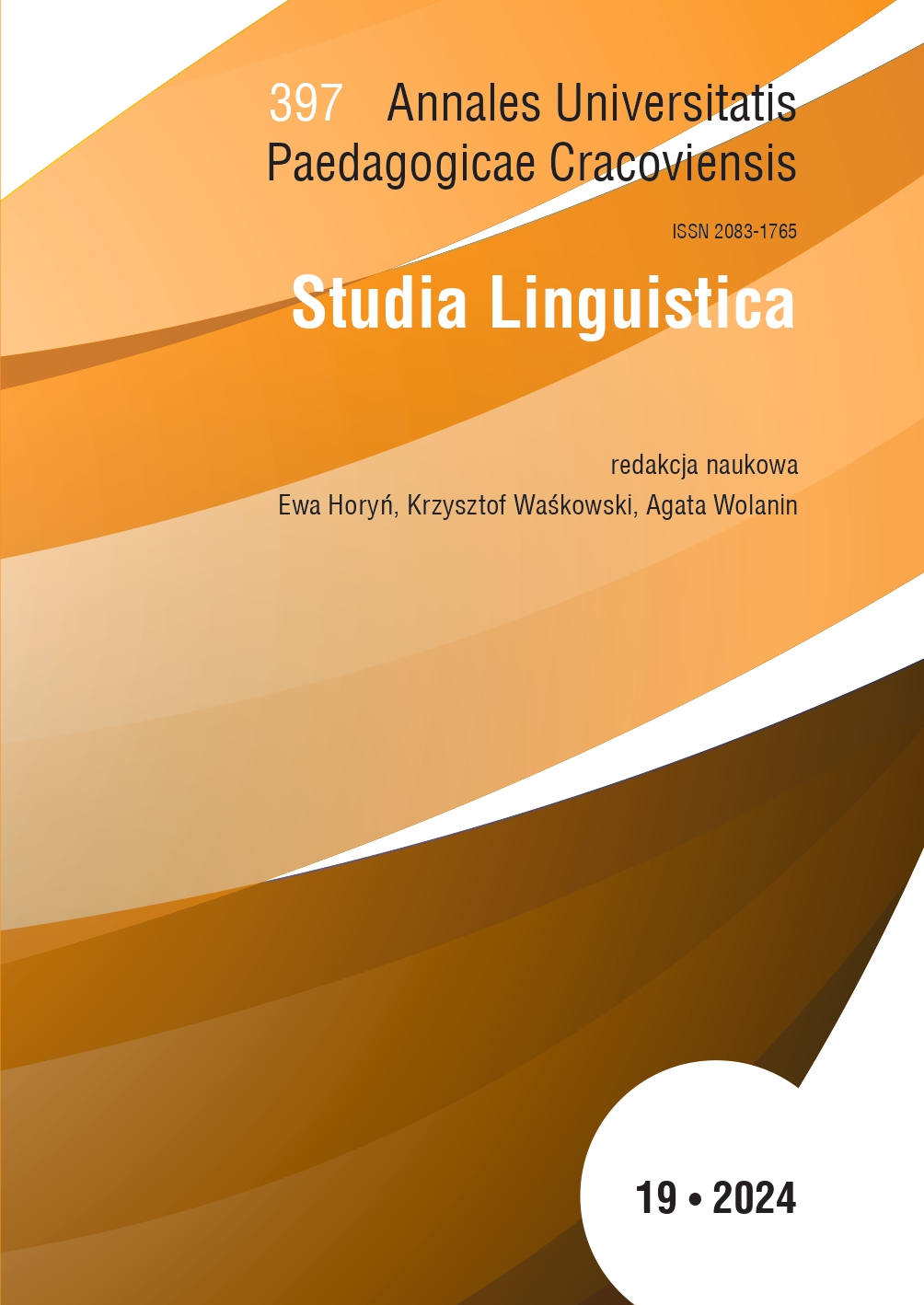Traditions of a country home preserved in the speech of Spisz inhabitants
Main Article Content
Abstract
The article presents a traditional image of a country home in Spisz. The material basis is the electronic corpus of rural speech (Korpus Spiski 2015–2019). The collocations of the lemmas: dom, chałupa, izba were observed during the analysis of corpus materials. The study of collocations allows us to clarify the semantics of lexemes. The names dom and chałupa have a characteristic dialectal understanding: ‘a rural farm belonging to one owner, including farm buildings, animals and equipment’. This meaning does not occur in the noun izba. Semantic and pragmatic structures describing traditional elements and forms of life associated with a country home were extracted from broader contexts. The traditional image of the Spisz home reveals two profiles: physical (residential building, farm) and symbolic (center of community family life, place of important events and celebrations, farm work, neighborhood meetings). Finally, the transformations that have taken place in the farmhouse are mentioned.
Downloads
Article Details

This work is licensed under a Creative Commons Attribution-NonCommercial-NoDerivatives 4.0 International License.
Author, submitting a text to the editorial board of the journal “Annales Universitatis Paedagogicae Cracoviensis. Studia Linguistica", certifies that the content of the article has not been published so far and that the work does not violate in any way the copyright or related rights of other person, as well as other rights of third parties, and that no one's rights to the work (or any part thereof) have been missed. After signing the contract, the property rights to the published materials are transferred to the Scientific Publisher of the University of the National Education Commission, Krakow.
“Annales Universitatis Paedagogicae Cracoviensis. Studia Linguistica” is an open access journal, and all its content is made available free of charge to users and institutions under the Creative Commons CC-BY-NC-ND 4.0 license (attribution, non-commercial use, no derivative works). Under this license, the authors agree that their work may be lawfully reused for any purpose, except for commercial purposes, without the prior consent of the author or publisher. Everyone can read, download, copy, print, distribute and process these works, provided that the author's marking and the original publication place are correct. Published texts may not be used to create derivative works (e.g. to translate and publish in another language without the consent of the publisher). This is in line with the BOAI (Budapest Open Access Initiative) definition. "Studia Linguistica" does not charge for submitting or processing articles.
References
Bartmiński J. (red.), 2015, Leksykon aksjologiczny Słowian i ich sąsiadów, t. I, Lublin.
Google Scholar
Bartmiński J., 2008, Dom i świat – opozycja i komplementarność, „Postscriptum Polonistyczne” 1 (1), s. 55–68.
Google Scholar
Bartmiński J., Bielińska‑Gardziel I., 2015, Polski językowo‑kulturowy obraz DOMU i jego profile, [w:] Leksykon aksjologiczny Słowian i ich sąsiadów, red. J. Bartmiński, t. I, Lublin, s. 89–121.
Google Scholar
Benedyktowicz D. i Z., 1992, Dom w tradycji ludowej, Wrocław.
Google Scholar
Benedyktowicz D. i Z., 2023, Symbolika domu. Literatura i etnografia, Kraków.
Google Scholar
Fedorowicz I., Geben K., 2021, Językowy obraz domu w prozie wspomnieniowej Wojciecha
Google Scholar
Piotrowicza, Vilnius University Open Series (2), s. 318–333, https://www.zurnalai.vu.lt/open-series/article/view/24586 (dostęp: 10.02.2024).
Google Scholar
Grabski M., 2012, Budownictwo drewniane, [w:] Kultura ludowa Górali Spiskich, red. U. Janicka‑Krzywda, Kraków, s. 93–108.
Google Scholar
Grochola‑Szczepanek H., 2021, Od nagrania do korpusu, czyli o metodzie archiwizowania języka mówionego mieszkańców wsi z wykorzystaniem narzędzi lingwistyki cyfrowej, „Annales Universitatis Paedagogicae Cracoviensis. Studia Linguistica” XVI, 2, s. 54–67.
Google Scholar
Grochola‑Szczepanek H., Górski R.L., von Waldenfels R., Woźniak M., 2019, Korpus języka mówionego mieszkańców Spisza, „LingVaria” LV/1, s. 165–180.
Google Scholar
Grochola‑Szczepanek H., Woźniak M., 2018, Transkrypcja języka mieszkańców wsi w aplikacji ELAN w Korpusie Spiskim, [w:] Historia języka, dialektologia i onomastyka w nowych kontekstach interpretacyjnych, red. R. Przybylska, M. Rak, A. Kwaśnicka‑Janowicz, Kraków, s. 267–278.
Google Scholar
Kąś J., 2015–2019, Ilustrowany leksykon gwary i kultury podhalańskiej, t. I–XII, Bukowina Tatrzańska – Nowy Sącz.
Google Scholar
Korpus Spiski, 2015–2019, Język mieszkańców wsi. Korpus tekstów i nagrań gwarowych, https://www.spisz.ijp.pan.pl (dostęp: 10.02.2024).
Google Scholar
Misiak M., 2016, Językowy obraz DOMU w etnolekcie łemkowskim. Analiza danych słownikowych, „Slavistica Vilnensis” 60, s. 61–74, https://www.zurnalai.vu.lt/slavistica--vilnensis/article/view/9931/7771 (dostęp: 10.02.2024).
Google Scholar
Rutkovska K., 2015, Koncept domu (namai) w języku i kulturze litewskiej, [w:] Leksykon aksjologiczny Słowian i ich sąsiadów, red. J. Bartmiński, t. I, Lublin, s. 61–87.
Google Scholar
Sawaniewska‑Mochowa Z., Zielińska A., 2007, Dziedzictwo kultury szlacheckiej na byłych Kresach północno‑wschodnich Rzeczypospolitej: ginąca cześć kultury europejskiej, Warszawa.
Google Scholar
Sawicka G. (red.), 1997, Dom w języku i kulturze, Szczecin.
Google Scholar
Siemieńska R., 1962, Z badań nad zagadnieniem trwania i przeobrażania więzi społecznej we wsi spiskiej, praca magisterska wykonana w Katedrze Etnografii Ogólnej i Socjologii UJ pod kier. K. Dobrowolskiego, Kraków (maszynopis).
Google Scholar
Sobierajski Z., 1966, Atlas polskich gwar spiskich, Poznań.
Google Scholar
